The computer during operation has the ability to litter with all sorts of unnecessary folders and files, entries in the registry. And, of course, it is imperative to get rid of all this "digital trash" - periodically clean the computer, so to speak, at the software level.
In this article, you will learn how to clean your computer from garbage using regular windows tools and through special programs.
How to clean PC utilities?
On the Web you can find a huge number of utilities that remove garbage from a computer in auto mode. But we will get acquainted with the most successful solutions that have proven themselves in practice (i.e., they clean up garbage on the computer with the highest quality).
Ccleaner
Powerful and at the same time easy to use program for cleaning the computer from the English company Piriform Ltd. Distributed for free (Free version) and shareware (Professional and Professional Plus versions). Correctly neutralizes "system garbage" from registry branches, windows partitions and program directory. Able to clean the browser cache, memory dumps, OS logs. It has additional functions: managing startup and task scheduler, uninstalling programs, setting the context menu. Delicately and efficiently optimizes the registry: analyzes DLLs, detects invalid extensions, Class and ActiveX errors, application paths and other elements cluttering up the computer.
1. Open the official page for downloading the utility in the browser - http://www.piriform.com/ccleaner.
2. Click the green button “Download Free Version” (download the free version of the program).
3. On the new page, click “... download” in the first panel again.

4. In the table, in the first column (Free), click on the link “Download.com”.

5. Run the downloaded installer.
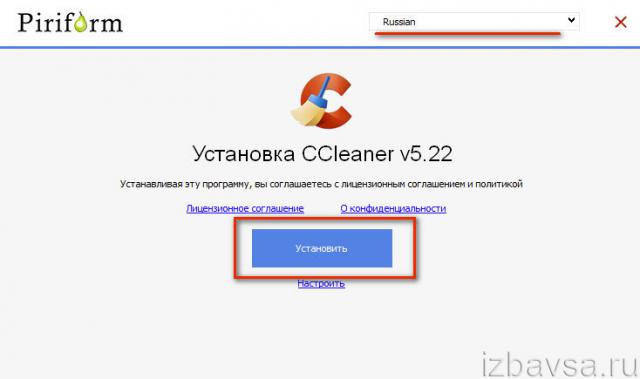
6. In the installer window, in the drop-down list, select "Russian". Click on the blue Install button.
7. Run the utility. To completely remove unnecessary files from the PC, in the "Cleaning" section, click "Analysis", and then, when the scan is complete, click on "Cleaning".

8. Open the "Registry" section. Click “Troubleshoot”, and after checking, click “Fix ...”.
Solution from Chinese developers. With a few clicks of the mouse, the PC completely eliminates unnecessary, useless files and registry keys. It is licensed by Freeware (provided to users for free). Fully compatible with all windows versions, supports English and Russian. It monitors disk space and optimizes the system efficiently. Detects software trash accurately.
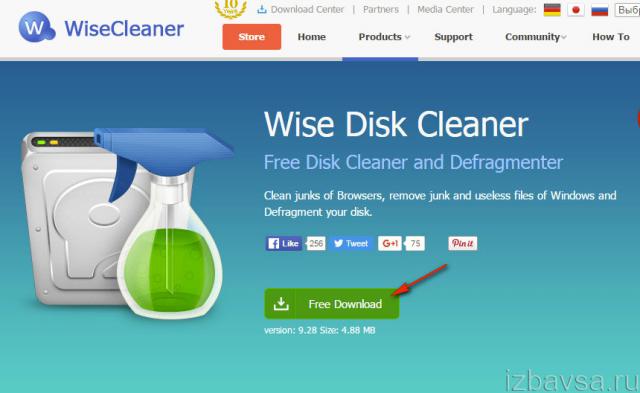
1. Open the utility off-site - http://www.wisecleaner.com/wise-disk-cleaner.html.
2. In the installer window, in the "Install SpyHunter" panel, click "Decline" to disable the installation of additional anti-virus software.

3. Click “Install.”
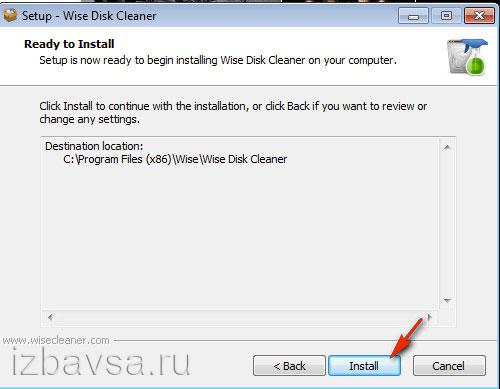
4. After the installation is complete, run the utility.
5. In the "Quick Cleanup" section, select the objects that you want to completely neutralize from the OS or to clean.
6. Click Search, and then click Clean.
Note. You can also use the “Deep Cleaning” function.
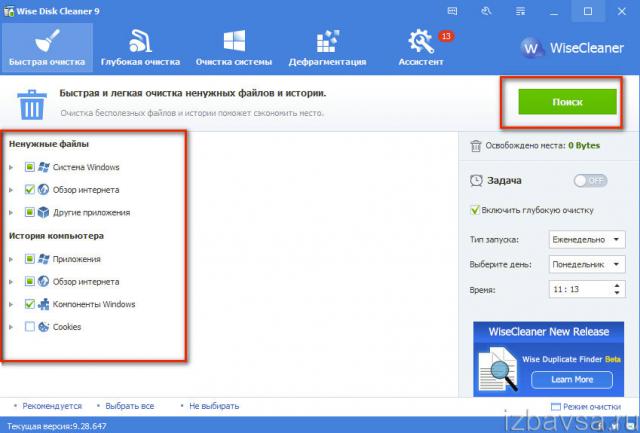
A multifunctional utility for servicing Windows operating systems. Provided shareware (there is a trial - a trial period of use without a license). Completely frees the OS from garbage, speeds up its work. Endowed with comfortable functions for managing startup and registry entries. Cleaning is carried out in automatic mode, displays found useless items, monitors disk space. Keeps track of registry changes.
1. On official page for download - http://www.chemtable.com/en/organizer.htm - click the "Download" button.

2. Install and run Reg Organizer.
3. Click on the “Disk Cleanup” section in the menu.

4. Click “Scan." After verification, activate the “Run Cleanup” command.
Winptimizer
A comprehensive Windows optimizer developed by the German company Ashampoo. It combines a large number of utilities and functions for software "tuning" of the system. Accelerates PC operation, correctly frees up free disk space without violating the integrity of system directories and processes. Available on offsets in paid and free version. It has options for creating fine-tuning the system (Tweaking Tool), a module for cleaning up traces of Internet browsing, built-in drive utility Cleaner to neutralize digital junk from PC drives. It is able to detect spyware and defragment your hard drive.
1. On the off-line application developer, open - www.ashampoo.com.
2. In the upper panel, set the Russian language of the interface.
3. Click on the “Downloads” section.
4. In the table, select one of the versions of WinOtimizer (Free, 12, 14 or 2016): in the panel, click "Download".
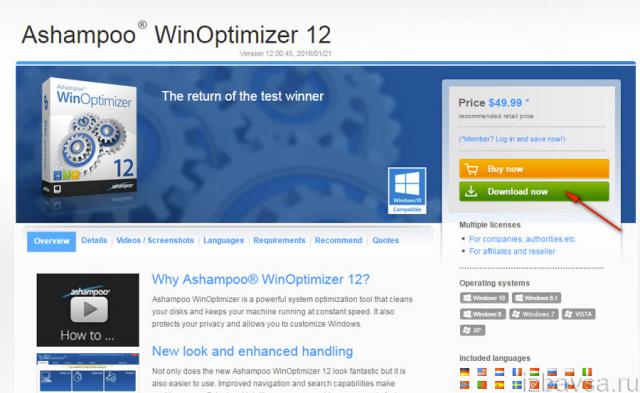
5. Run the installer, in the window that opens, if necessary, configure the installation (specify the path, access, create shortcuts). Click "Next."

6. Click on the “Favorites” tab and select the “Drive Cleaner” icon.
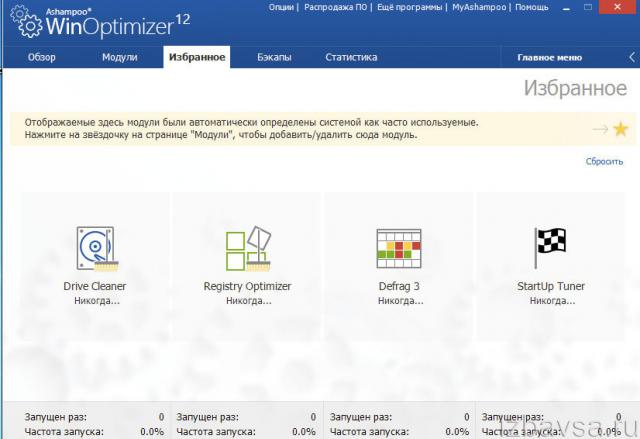
7. At the end of the OS check, click the “Delete” button to get rid of unnecessary objects.
![]()
"Cleaning" the computer with regular functions
Cleaning the system partition
1. Press the key combination - Win + E.

2. In the Run panel, specify the command - cleanmgr.exe. Click “OK.”
3. In the window with the settings that appears, select the objects that you want to delete (click the “bird” next to them). And then click “Clear system files».
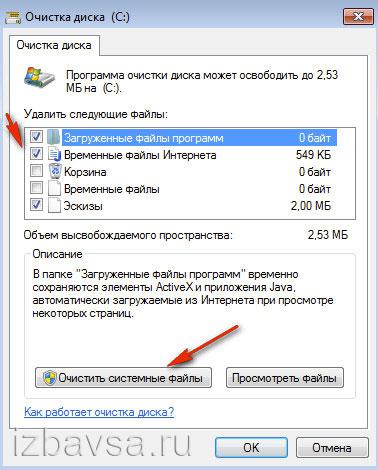
Removing garbage from the Temp folder
1. Open a temporary file vault:
C drive → Users → → AppData → Local → Temp
2. Press Ctrl + A to select all the files in the folder.

3. Right-click on them. In the list of Windows options, select Uninstall. Empty the “Recycle Bin” (its icon is located on the desktop).
Delete unwanted files from browsers
1. Having finished work on the Internet, being in a browser window, press “Ctrl + Shift + Del” (this “hot” combination works in almost all popular browsers - Firefox, Google chrome, Opera, etc.).
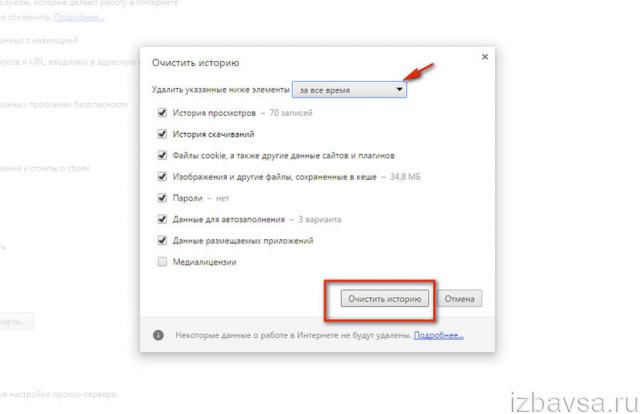
2. In the settings panel, specify for what period you want to delete the saved temporary files (it is recommended to set the value to "All time").
3. Select the items (what you want to delete).
4. Click on the “Clear .... ".
Have a successful PC cleaning! Always keep it clean and tidy and it will never let you down.
Before you start, you need to. Downloading won't take you away a large number time. In a few minutes you will be able to launch the “Installation Wizard”, it will help to unpack the program files to the folder you specified on the PC correctly. Do not forget to create a software shortcut on your desktop. With it, you can run software much faster when you use it later.
![]()
Step 2. Delete junk files
Junk files include objects moved to temporary storage in the trash, as well as data from the browser that is saved when using the Internet. But not all temporary files are easily detected manually on a PC without special software. Launch Accelerator and go to the tab "Cleaning". In the menu presented, mark the types of files that the application needs to find, and then click "Scan". Wait for it to finish. If desired, review the report, and then instruct the program "Fix" detected objects. All unnecessary files will disappear from your computer at that moment.
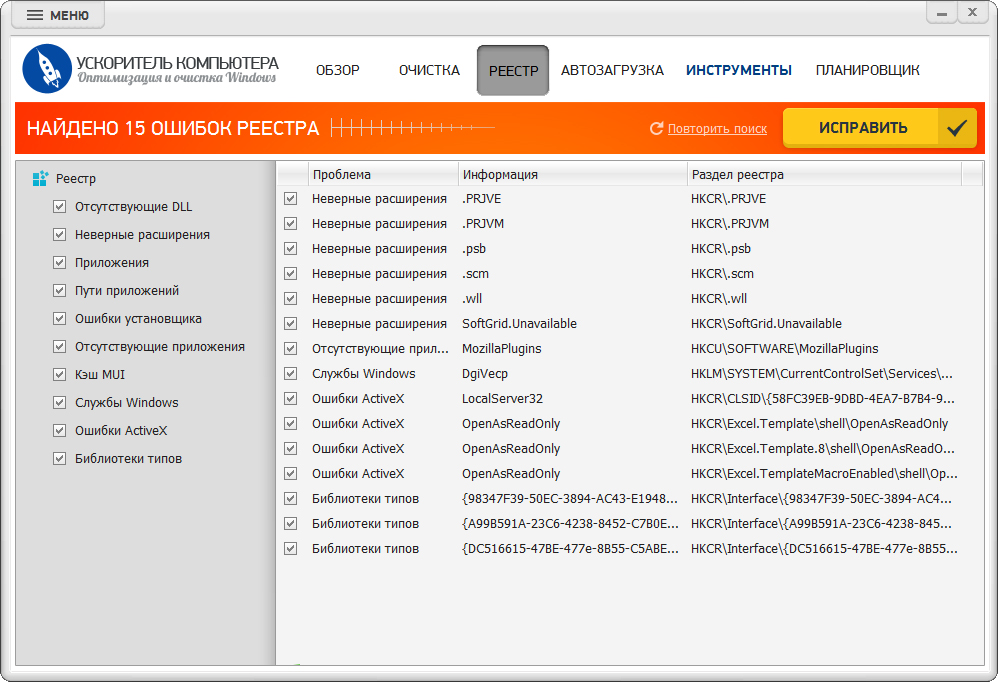
Step 3. Clean the registry
The registry is a database of the system, which is also cluttered with prolonged active use of the computer. Often, most of the materials collected there are completely not required for work for you or your PC. Go to the tab "Registry". Indicate the type of files that the program needs to find, and then, as in the previous step, run the scan. According to its results, a list of problems appears on the screen, as well as the registry section in which they were found. Click "Fix" and you can quickly and efficiently clean your computer.
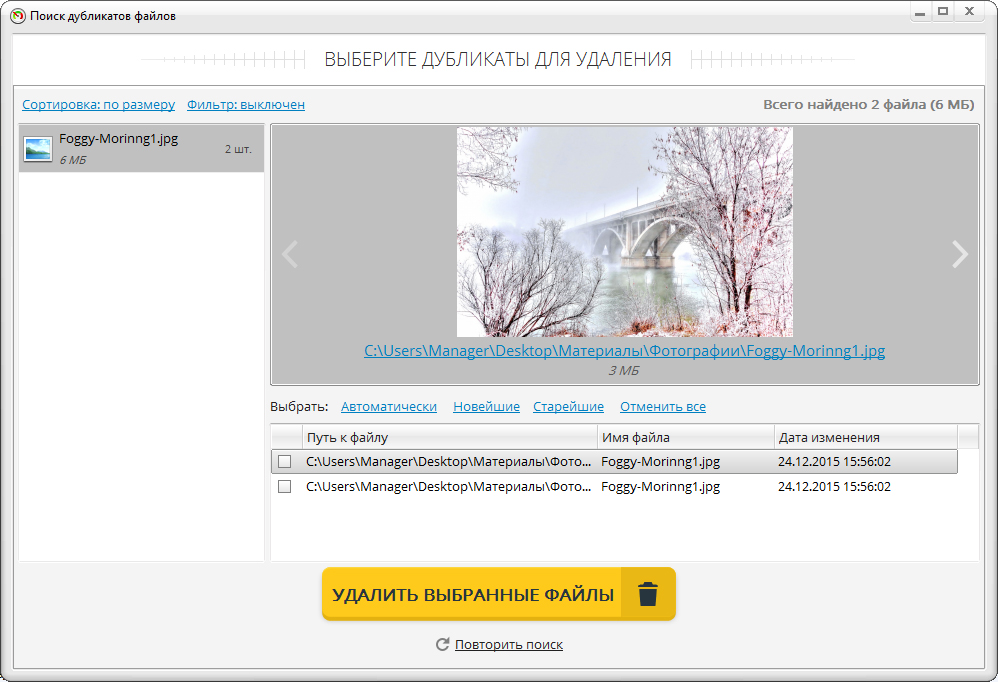
Step 4. Finding duplicates
Duplicate files also apply to garbage. They can be scattered here and there throughout the memory of your computer, as well as adjacent to each other in the same folder, differing only in name. Go to the “Accelerator" in the menu "Instruments" and click on the function. Indicate which folders the program should scan for clone files and specify other criteria. After that, a list of duplicates and information about their location will appear on the screen. Also do not forget about not necessary programsoh. You can find out in another article in the textbook.
Congratulations! Now you know how to clean your computer of debris. Carry out such checks from time to time, and the laptop will always delight you with its operational work. Computer Accelerator is a program that can breathe life into your old technique. Install it today, and in the very near future you will notice improvements in your PC.
- C: \\ Documents and Settings \\ username \\ Local Settings \\ History
- C: \\ Windows \\ Temp
- C: \\ Documents and Settings \\ username \\ Local Settings \\ Temp
- C: \\ Documents and Settings \\ Default User \\ Local Settings \\ History
For windows 7
- Temporary windows files:
- C: \\ Windows \\ Temp
- C: \\ Users \\ Username \\ AppData \\ Local \\ Temp
- C: \\ Users \\ All Users \\ TEMP
- C: \\ Users \\ All Users \\ TEMP
- C: \\ Users \\ Default \\ AppData \\ Local \\ Temp
- Opera cache:
- C: \\ users \\ username \\ AppData \\ Local \\ Opera \\ Opera \\ cache \\
- Mozilla Cache:
- C: \\ Users \\ username \\ AppData \\ Local \\ Mozilla \\ Firefox \\ Profiles \\
- Temporary Internet Files:
- C: \\ Users \\ username \\ AppData \\ Local \\ Microsoft \\ Windows \\ Temporary Internet Files \\
- Recent documents:
Some folders may be hidden from prying eyes. To show them you need to be allowed to show hidden files and folders.
2. Disk cleaning from temporary and unused files using
Standard Disk Cleanup tool
- 1. Go to "Start" -\u003e "All Programs" -\u003e "Accessories" -\u003e "Utilities" and run the program "Disk Cleanup".
- 2. Select a disk to clean:
The disk scanning process will begin ...
- 3. A window opens with information about the amount of space occupied by temporary files:
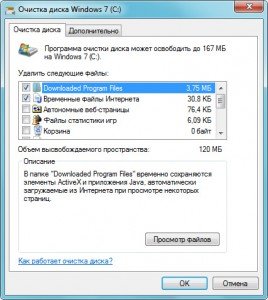
Check the boxes next to the partitions you want to clear and click OK.
- 4. But that is not all. If you did not install Windows 7 on blank disk, and on top of the previously installed operating system, you probably have folders that take up a lot of space, such as Windows.old or $ WINDOWS. ~ Q. It may also make sense to remove control points system recovery (except the last). To perform this operation, repeat steps 1-3, but this time click "Clear system files":

- 5. After the procedure described in clause 2, the same window will open, but the “Advanced” tab will appear at the top. Go to her.

In the "System Restore and Shadow Copy" section, click "Clear."
3. Pagefile.sys and hiberfil.sys files
Files located at the root system disk and take up quite a lot of space.
- 1. The pagefile.sys file is a system paging file (virtual memory). You can’t delete it (it’s not recommended to reduce it as well), but you can and even need to move it to another drive. This is done very simply, open the "Control PanelSystem and SecuritySystem", select "Advanced system settings" in the "Performance" section, click "Settings", switch to the "Advanced" tab (or press the key combination win + R and the run command opens and type SystemPropertiesAdvanced there ) and in the "Virtual memory" section, click "Change." There you can choose the location of the swap file and its size (I recommend leaving “Size at the choice of the system”).

- 2. The hiberfil.sys file is an image random access memory for sleep mode (hypernation mode).
4. Removing unnecessary programs from disk
A good way to free up disk space (and as an added bonus to increase system performance) is to remove unused programs.
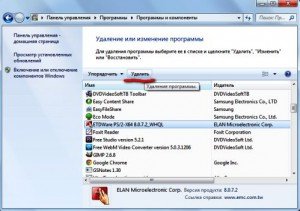
Go to the control panel and select "Uninstall programs." A list will appear in which you can select the program that you want to remove and click "Delete".
5. Defragmentation
Defragmentation hard drivecarried out by the defragmenter allows you to organize the contents of the clusters, that is, move them to disk so that clusters with the same file are placed in series, and empty clusters are merged. This leads to an increase in the speed of access to files, and therefore to a certain increase in the speed of the computer, which with a high level of fragmentation of the disk can be quite noticeable.
The standard disk diffragmentation program is located along the path:
start\u003e all programs\u003e standard\u003e utility\u003e disk defragmenter
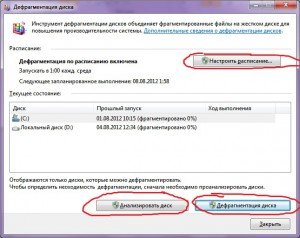
Do disk analysis before defragmenting. After the analysis, a dialog box is displayed with a diagram of the percentage of fragmented files and folders in the disk and a recommendation for action. Analysis is recommended to be carried out regularly, and defragmentation only after the appropriate recommendation of the disk defragmentation program. Disk analysis is recommended at least once a week.
If the need for defragmentation is rare, the interval for performing disk analysis can be extended to one month.
After adding a large number of files or folders, disks may become excessively fragmented, so in such cases it is recommended to analyze them.
For complete and proper defragmentation using the Disk Defragmenter program, a disk must have at least 15% free space. Disk Defragmenter uses this volume as an area to sort file fragments. If the volume is less than 15% of free space, then the Disk Defragmenter program will perform only partial defragmentation. To free up additional disk space, delete unnecessary files or move them to another disk.
Defragment disks after installing the software or after updating or clean installation Windows After installing the software, disks are often fragmented, so running Disk Defragmenter helps ensure the highest file system performance.
You can save a little time on defragmenting if you remove it from the computer before starting the operation junk filesand also exclude from consideration the system files pagefile.sys and hiberfil.sys, which are used by the system as temporary, spooled files and are recreated at the beginning of each Windows session.




